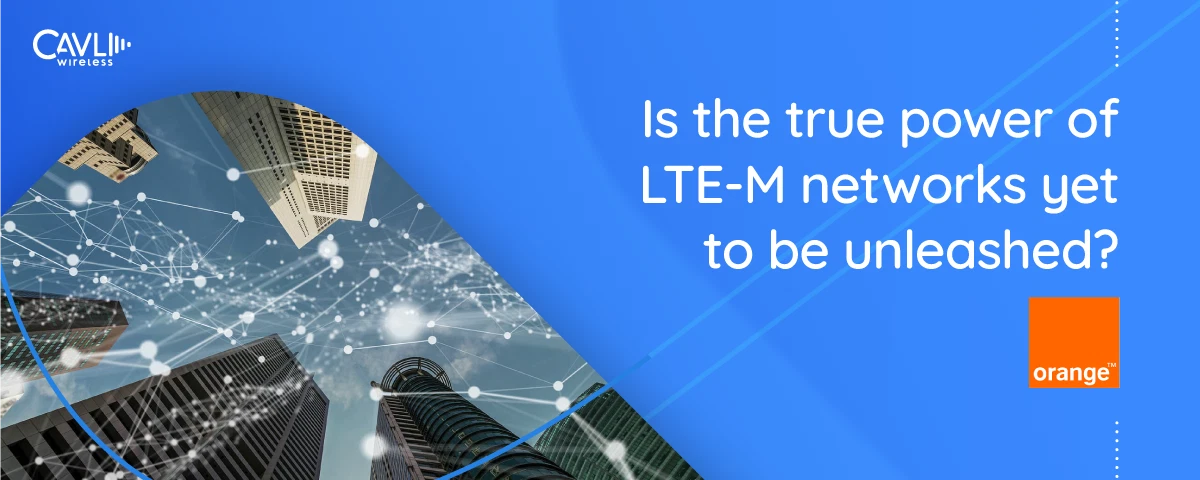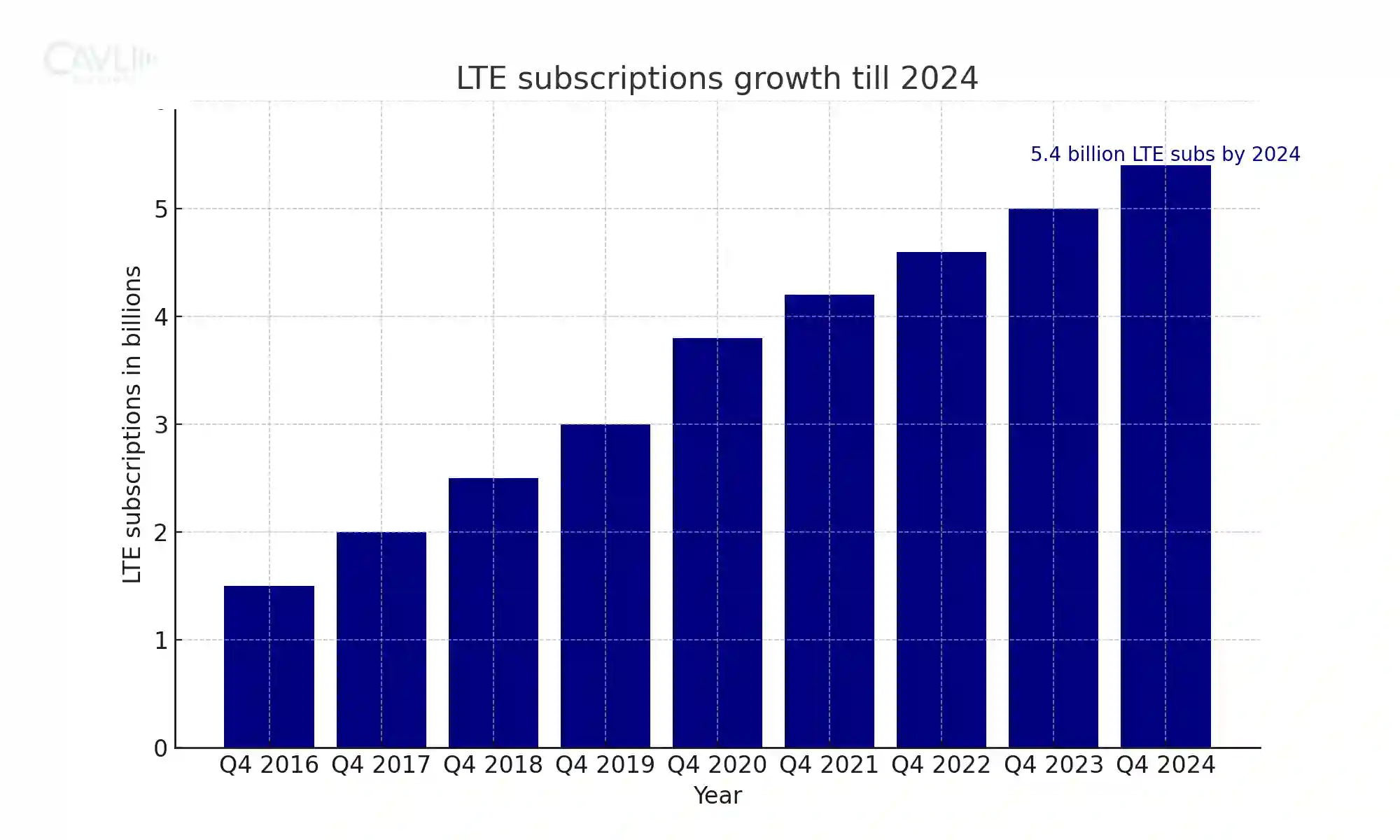The 2G Sunset has set technological constrain on enterprises hugely dependent upon the 2G network. Access the use case document to learn how to transit from 2G to existing networks without major device changes or field recalls.
Access the Document Now
The 3rd Generation Partnership Project (3GPP) Release 15 has officially launched 5G
networks, yet the adoption of LTE (Long Term Evolution) remains strong.
Since its 2010 release, LTE has seen substantial investments from Mobile Network Operators (MNOs) worldwide, enhancing network coverage and providing affordable high-speed devices. Even in 2024, LTE is crucial, with many regions still upgrading their infrastructure to meet high-speed connectivity demands.
The integration of LTE with emerging 5G networks is essential for seamless connectivity, especially in areas where 5G is not fully deployed. LTE advancements, such as LTE Advanced and LTE Advanced Pro, continue to push network performance boundaries, ensuring LTE's relevance in modern telecommunications.
While 5G is set to revolutionize the industry, LTE remains vital. The combined efforts of LTE and 5G will shape future connectivity, offering reliable high-speed services globally.

As reported by the GSA, the contribution of LTE to mobile subscribers has steadily climbed up the ladder over the years. The source reported that the end of 2016 witnessed a massive increase in the number of global LTE subscribers that reached up to 1.52 Bn. It has also forecasted that the number of 4G connections is expected to double by 2020 moving from 23% in 2016 to 45% in 2020. GSA predicts that the number of LTE subscribers would hit 3.8 Bn by the end of 2020.
LTE-M, the industry term for LTE MTC (LTE - Machine Type Communication), which refers explicitly to LTE-M1, is an abbreviation for Long Term Evolution (4G) category M1 or Long Term Evolution of Machines. The radio technology is a standards-based protocol that offers extended indoor and subterranean coverage and is apt for Low Power Wide Area IoT applications, supporting a battery life for smart devices longer than 10 years.
What is LTE Network?
LTE, which stands for Long-Term Evolution, is a standard for wireless broadband communication for mobile devices and data terminals. LTE networks are designed to increase the capacity and speed of wireless data networks using advanced technologies. Unlike its predecessors, LTE is based on an all-IP network architecture, which improves spectral efficiency, reduces latency, and enhances overall user experience. With its higher data rates and low latency, LTE networks are pivotal in supporting the growing demand for mobile internet access, facilitating smooth streaming of high-definition videos, faster web browsing, and seamless online gaming. The deployment of LTE networks across the globe has significantly transformed how people connect and communicate, making it the backbone of modern mobile connectivity and paving the way for future advancements like 5G.
Deep Dive into LTE Technologies
To fully grasp the potential of LTE-M in the IoT landscape, it's essential to explore a range of related technologies such as LTE Cat M1, LTE Cat NB1, LTE Cat M2, EC-GSM IoT, LTE Cat 1, Cat 4, Cat 6, and Cat 1bis. Each of these technologies brings unique features that contribute to the broader ecosystem of the LTE network, catering to different needs from high-speed data requirements to extensive coverage and power efficiency.
-
LTE Cat 1, Cat 4, and Cat 6
These categories of LTE technologies offer varied data rates suitable for different applications. LTE Cat 1 supports data rates up to 10 Mbps, making it ideal for applications like video surveillance and advanced telematics that require moderate data throughput.
LTE Cat 4 and LTE Cat 6, providing data rates up to 150 Mbps and 300 Mbps respectively, are perfect for data-heavy applications in urban environments such as HD video streaming and high-speed mobile broadband. These technologies enable high-performance connectivity for smart city infrastructures and connected vehicle systems, ensuring efficient handling of high-volume traffic and real-time data transmission. -
LTE Cat M1
Balancing speed with power efficiency, LTE Cat M1 supports data rates up to 1 Mbps. It is particularly beneficial for applications that require moderate data transmission like wearables and asset trackers. Compatible with existing LTE networks, LTE Cat M1 offers broad coverage and reliable connectivity, enhancing devices with extended battery life and robust connection capabilities. For instance, in logistics, LTE Cat M1-equipped asset trackers provide continuous updates on the location and condition of goods, facilitating timely deliveries and efficient supply chain management.
-
LTE Cat NB1 (NB-IoT)
Designed for applications that require ultra-low data rates, LTE Cat NB1, also known as NB-IoT, excels in scenarios such as smart meters and environmental monitoring. It operates within a narrow bandwidth, ensuring deep indoor penetration and minimal power consumption, making it ideal for battery-operated devices. This technology is crucial for smart city applications, such as monitoring air quality and managing street lighting, where devices need to transmit minimal data over extended periods.
-
LTE Cat M2
An advancement over Cat M1, LTE Cat M2 offers higher data rates and improved spectral efficiency, suitable for data-intensive applications like industrial automation. It allows IoT devices to transmit substantial data volumes swiftly and reliably, facilitating real-time monitoring and control of industrial processes which enhances productivity and reduces downtime.
-
EC-GSM IoT
This technology extends the life of GSM networks, providing IoT connectivity in areas with sparse LTE coverage. It supports long battery life and extensive coverage, making it an ideal choice for rural and remote IoT applications such as agricultural monitoring and irrigation management in distant fields, ensuring optimal resource use and crop growth.
Comprehensive Technical Specifications of LTE-M
-
Data Rates
LTE Cat M1 provides up to 1 Mbps, while LTE Cat NB1 offers up to 250 kbps. LTE Cat M2 can exceed these speeds, making it suitable for applications with higher data requirements.
-
Latency
LTE-M technologies ensure low latency, critical for real-time applications. LTE Cat M1, for instance, achieves latency as low as 10 ms under optimal conditions.
-
Battery Life
With features like Power Saving Mode (PSM) and extended Discontinuous Reception (eDRX), LTE-M technologies support battery life of over 10 years, essential for devices like smart meters.
Applications and Use Cases of LTE-M
LTE-M supports several low-power IoT applications such as sensor monitoring, asset tracking, fleet tracking (Fleet Management Solutions), applications requiring real-time communication, Industry 4.0 applications, etc. Use cases include Smart Utility Metering, Fleet Management Solutions, Patient monitoring systems, Asset management solutions, Preventive Maintenance, etc. As of 2024, LTE-M coverage has expanded to 45 countries around the world, with over 60 Mobile Network Operators (MNO) supporting the technology, reflecting its growing adoption and implementation.

Fleet Management Solution
Fleet Management Solutions empower SMBs & Enterprises to optimize schedules and routes for their logistics departments—whether for vehicles traversing interstate highways or heavy engineering vehicles operating within predefined geo-fences. With comprehensive LTE-M coverage, these solutions enable remote optimization of vehicle routes, monitoring of driver behavior, and improvements in productivity and cost-efficiency, thus enhancing the overall efficiency of fleets. The integration of LTE, including LTE Cat 1, LTE Cat 4, and LTE Cat 6 technologies, ensures high-speed data transmission and reliable connectivity across vast geographic areas.
Smart Utility Metering
As the need for intelligent and sustainable environments grows, smart city projects are increasingly adopting Smart Utility Metering solutions. These systems, supported by LTE, LTE-M, and NB-IoT technologies, allow energy distribution authorities to remotely monitor and control the distribution and consumption of resources efficiently. The robust connectivity provided by LTE ensures reliable data communication, critical for the real-time management and operation of smart grids and other utility infrastructure.


Predictive Maintenance
In industrial environments, such as factories, the timely inspection of heavy machinery and equipment is crucial to detect signs of wear or damage. IoT-enabled predictive maintenance techniques, facilitated by the Industrial Internet of Things (IIoT) and enhanced by LTE connectivity, help determine the condition of in-service equipment to schedule maintenance accurately. The use of LTE and NB-IoT in these scenarios ensures rapid data transfer and reliable connectivity, crucial for detecting anomalies and preventing faults before they occur.
Micromobility
Micromobility services offer an eco-friendly, cost-effective solution to urban traffic congestion. By integrating stakeholders like traffic authorities, product manufacturers, platform operators, and government agencies, and utilizing LTE technology, these services enhance transportation safety, cleanliness, efficiency, and reliability. The support of LTE ensures seamless communication and data sharing among all parties involved, making transportation systems more adaptive and responsive to urban needs.

Advanced Features of LTE-M
-
Power Saving Mode (PSM)
Extends battery life by allowing devices to enter deep sleep states. PSM is crucial for devices that are deployed in the field for extended periods without easy access to power.
-
Extended Discontinuous Reception (eDRX)
Reduces power consumption by extending intervals between signal receptions. This feature allows devices to conserve energy, making them more efficient and longer-lasting.
-
VoLTE Support
Enables voice services over LTE, useful for applications requiring audio communication. VoLTE ensures that voice communications are clear and reliable, even over data-centric networks like LTE.
Unleashing the true power of LTE-M networks for IoT applications
With a motive to democratize IoT for everyone and unleash the true power of LTE-M networks, Cavli Wireless and Orange Business Services are coming together to offer seamless LTE-M connectivity for IoT applications through Hubble99.
C-Series IoT modules, C42QM and C42GM, as part of Cavli’s flagship IoT hardware- SaaS bundle, the Hubble, bundled with LTE-M connectivity services offered by Orange Telecom will be able to power innovative use cases in smart city applications, smartwatches, critical asset & fleet tracking, and other industry 4.0 applications.
Cavli’s Hubble99 is the world's first truly subscription-based IoT offering with ZERO hardware cost. For an irresistible package price of $0.99/month/device, IoT solution players get the eSIM integrated connectivity hardware of their choice of technology ( on LPWAN/LTE technologies - NB IoT, LTE-M, Cat 1, Cat 4, 2G, 3G), pre-loaded IoT data subscription (ranging from 5 MB - 30 MB), and a robust Connectivity-Device management cloud platform- Cavli Hubble all bundled into one single package. This plan enables Cavli’s enterprise customers to avail the cellular IoT modules, global connectivity, and device management platform, without an upfront CAPEX, while providing extended battery life for their IoT devices.
Cavli Wireless already has access to LTE-M networks in Europe and North America. By collaborating with Orange Business Services, our C42QM and C42GM LTE Cat M1/NB-IoT module will have seamless LTE-M connectivity, globally. Cavli’s partnership with Orange Business Services will witness the onboarding of approximately 200k devices live on Hubble99 in the next 12 months. Cavli Hubble through the Orange LTE-M network will move freely across regions without hitting connectivity or power issues.
Uninterrupted LTE-M network access coupled with a cost-effective IoT adoption plan can accelerate IoT use cases worldwide, thereby unleashing the true power of LTE-M networks.
“IoT can finally achieve true mobility with LTE-M. Devices can move unrestricted over a wide range, opening up new application opportunities that would otherwise be impossible using 3G or 4G. LTE-M is the best low power solution for tracking applications, and Orange has been a pioneer in LTE-M across Europe along with the best reach through roaming coverage,” said John Mathew of Cavli

The decline of 2G
Originally designed for voice calling in mobile communications and for applications requiring small amounts of data, 2G networks are popularly known for its reliability but sadly infamous for being among the slowest cellular connections in the market. This makes it difficult to achieve stable connectivity in hard-to-reach areas. With the bandwidth levels reaching its peak in the frequency range allocated for 2G, a new standard technology for its replacement is inevitable given the large adoption of smart connected devices/products in the years to come.
When compared to 2G, LTE-M networks offer a better solution in terms of remote coverage, data speeds, higher bandwidth & network capacity, longer battery life, and low device cost. While the transition remains challenging in several regions where IoT use cases such as Light Vehicle/Asset Tracking relies on 2G, it's about time that regulators and IoT product makers alike need to realize why LTE-M is the future of connected things. In most cases, simply adding a new modem to the existing infrastructure could be an easy solution. Although an entire replacement of the outdated infrastructure could potentially increase device functionality.
Future Trends and 5G Integration with LTE-M
-
3GPP Release 15 and Beyond
Future enhancements will further improve LTE-M's capabilities, aligning it with 5G IoT requirements. These enhancements include better data rates, lower latency, and improved power efficiency, making LTE-M even more suitable for a wide range of IoT applications.
-
Integration with 5G
LTE-M will complement 5G's massive IoT (mMTC) applications, providing seamless connectivity and scalability. The LTE network's infrastructure will serve as a foundational layer, supporting the vast number of devices that 5G aims to connect.
Go Beyond and Explore
LTE-M, optimized for low power consumption and extended coverage, can achieve a maximum range of approximately 10-15 kilometers in rural areas and 1-5 kilometers in urban settings. These ranges are subject to environmental factors such as terrain and building density. The technology is designed to enhance penetration in challenging environments, making it suitable for deep indoor and underground applications.
While LTE-M provides several advantages for IoT applications, it has limitations including:
- Lower Data Rate: Maximum throughput is typically limited to 1 Mbps, which may not be sufficient for data-intensive applications.
- Network Availability: Deployment is not yet universal; thus, coverage might be inconsistent depending on geographical location.
- Latency: It can exhibit higher latency compared to traditional LTE networks, potentially affecting real-time applications.
LTE-M (Long Term Evolution for Machines) is primarily used for IoT applications that require low power consumption, extended coverage, and moderate data rate demands. Typical applications include:
- Asset Tracking: Leveraging its extended range and penetration capabilities.
- Smart Metering: Due to its ability to transmit small data packets efficiently over long distances.
- Wearable Health Devices: Benefiting from its power efficiency and sufficient data rate for periodic health data transmission.
No, LTE-M is not the same as LTE 4G. LTE-M, or LTE Cat M1, is a technology derived from the LTE system and designed specifically for IoT applications. It supports lower data rates, consumes less power, and provides better coverage compared to conventional LTE (4G), which is geared towards higher-speed mobile data and voice services. LTE-M achieves its efficiency and coverage at the cost of bandwidth and speed, which are the primary strengths of traditional LTE networks.
LTE-M vs NB-IoT: Both are tailored for IoT but differ in usage scenarios. LTE-M supports higher data rates and mobility, making it suitable for mobile IoT applications, whereas NB-IoT is better for stationary applications that require smaller data packets and even lower power consumption.
LTE-M vs 5G: LTE-M operates under the 4G spectrum and is widely implemented for current IoT needs. 5G promises higher data rates, lower latency, and massive device connectivity, potentially absorbing and extending LTE-M applications into more data-demanding, real-time applications in the future.



